Stamped concrete is a stylish way to upgrade your outdoor space. But Understanding Stamped Concrete Cost: Factors That Affect Pricing and Budgeting is crucial. Homeowners often feel overwhelmed by fluctuating prices and hidden costs. Have you ever started a project only to realize your budget wasn’t enough? We’ve all been there. This blog will guide you through every cost factor, helping you plan your budget wisely and avoid surprises.
What Influences the Price? A Guide to Understanding Stamped Concrete Cost
Stamped concrete offers style and durability. However, prices can vary based on many factors. Let’s explore what impacts your final cost and how to plan.
Size and Complexity of the Project
Larger areas cost more because they need more materials and labor. Complex patterns also raise the price.
Here’s why:
- More square footage means more concrete.
- Custom designs take longer to install.
- Borders and edges need extra work.
Measure your space first and ask for a quote based on your design.
Type of Pattern and Color
The more detailed the pattern, the higher the cost. Simple textures are budget-friendly. Multiple colors or hand-stained finishes increase the price.
Consider these options:
- Basic Design: One color, simple texture – most affordable.
- Mid-Range: Two-tone with light detailing.
- High-End: Multi-color, custom stamps, hand finishing.
Complex colors look stunning but may require more maintenance.
Thickness and Reinforcement
Stamped concrete must be thick enough to support weight. Thicker slabs and extra reinforcement mean higher costs.
Your contractor may recommend:
- 4 inches thick: For patios and walkways.
- 6 inches or more: For driveways.
- Steel rebar or mesh: To prevent cracks.
Thicker concrete lasts longer, making it a smart investment.
Site Preparation and Location
Your site needs proper grading and prep. Uneven ground takes more time and equipment. Remote areas may also raise labor or delivery costs.
Look out for these hidden fees:
- Removing grass or existing concrete
- Hauling away debris
- Transport charges in rural zones
Proper prep prevents future problems and keeps your surface stable.
Sealing and Maintenance Needs
After stamping, sealing is required. It protects the surface from stains and weather damage. Sealant costs vary by quality and type.
You may need:
- A basic sealer every 2–3 years
- A slip-resistant coating for wet areas
- UV protection in sunny climates
Regular sealing adds to long-term costs, but it protects your investment.
Labor and Contractor Experience
Skilled contractors often charge more. However, their work lasts longer and looks better. Choosing based on price alone may lead to repairs later.
Ask these questions:
- How many stamped jobs have you done?
- Do you offer a warranty?
- Can I see past projects?
Hiring pros helps you avoid costly mistakes.
Seasonal and Regional Pricing
Prices can shift depending on the season and your location. Warm months are busier, so rates often rise. Materials and labor may also be more expensive in some states.
To save money:
- Book during the off-season
- Compare quotes from several local pros
- Watch for special deals or packages
Regional rates matter more than most people realize.
Add-Ons That Increase Cost
Some extras improve looks but increase price. Think carefully before adding these:
- Borders or engraving
- Stained logos or graphics
- Embedded lighting or water features
Focus on features that add both value and beauty.
Budgeting Tips to Stay on Track
Budgeting helps avoid overspending. Here are tips:
- Always get a detailed estimate.
- Set aside 10% for unexpected costs.
- Prioritize essential features first.
- Avoid last-minute design changes.
Planning ensures fewer surprises and more control over your project.
Ready to Plan Your Stamped Concrete Project?
Understanding stamped concrete cost: factors that affect pricing and budgeting is key to success. We’re here to help you make smart choices. Contact our team today for a free estimate. Let’s build something beautiful that fits your budget and adds lasting value to your space!





No comment